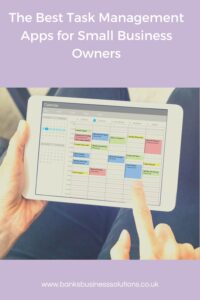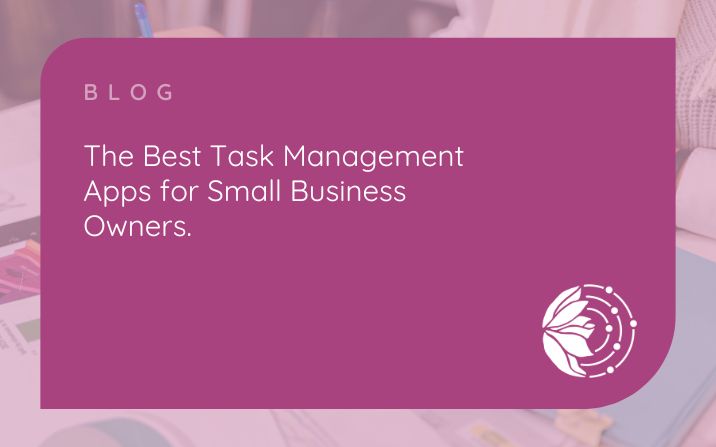Organise Like a Pro: Top Task Management Apps You Need to Try
Keeping track of the many tasks you need to perform for your business can be a bit of a nightmare at times. You might have various notebooks dotted all over the place, some notes on your phone and a spreadsheet or two on your computer but when was the last time you synced everything up and knew exactly what you needed to do and when those all-important deadlines are?
Task Management Systems are apps that help you keep on top of those tasks in an “at a glance” online system. Many of these apps have cloud and Android/Apple versions so you can add tasks when you’re out and about (or if you suddenly think of something while watching Netflix!)
With a plethora of task management tools at our fingertips, it’s essential to find the one that aligns perfectly with the specific needs and workflow of your business. This guide delves into the latest and greatest task management systems, offering insights into both time-tested favourites and exciting new contenders, to help you streamline your workflow and enhance productivity in the year ahead.
Asana: A Visual Approach to Task Management
Asana, renowned for its intuitive visual task display, remains a top choice for those who value a visually organised system. The interface uses intuitive navigation, making it easy for users to track projects and tasks at a glance. The layout is streamlined and the colour coding system allows for quicker identification of task status and priorities.
One of the standout features is the advanced workflow automation. This feature enables users to automate repetitive tasks, set up custom rules and create trigger-based actions, significantly reducing manual effort and increasing efficiency.
Asana has broadened its integration capabilities with a range of third-party apps. This expansion means users can now connect Asana with a wider array of tools they already use, such as time-tracking apps, CRM systems and communication platforms.
For small business owners, the combination of visual task management, enhanced automation and expanded app integration makes it a powerful tool for managing diverse projects and teams. It simplifies project oversight and enables small business owners to focus more on strategic tasks rather than getting bogged down in day-to-day management.
Basecamp: Simplifying Team Collaboration
Basecamp remains a steadfast ally in the world of team collaboration, continually evolving to offer more effective tools for communication and project management. One of the key strengths of Basecamp is its user-friendly interface. The design is intuitive, allowing both new and experienced users to navigate the platform with ease. This ease of use is essential for teams that need to onboard new members quickly, without the need for extensive training.
Integration with external tools is another area where Basecamp excels. The platform’s improved integration capabilities mean that teams can seamlessly connect Basecamp with other tools they use, creating a more efficient and cohesive workflow.
The platform now boasts a more intuitive messaging system, streamlined for ease of use and clarity. This improvement is crucial for teams that rely on clear and concise communication, particularly when coordinating with external partners.
Customisation is at the heart of Basecamp’s design. Teams can tailor their workspaces to suit their specific needs, setting up distinct areas for different projects or teams. This flexibility is particularly beneficial for managing multiple projects or collaborations simultaneously.
Finally, Basecamp’s centralised document storage system simplifies document management. It provides a single, accessible location for storing and collaborating on documents, which is especially useful for teams that frequently share and work on documents with external partners.
Google Tasks: Streamlined Task Management for the Minimalist
Google Tasks continues to be the preferred choice for individuals who value simplicity in their task management. Its appeal lies in its straightforward design and seamless integration with other Google services, making it a practical and uncluttered option for managing daily tasks.
The core strength of Google Tasks is its integration with Gmail and Google Calendar. This connectivity allows users to effortlessly create and manage tasks directly from their inbox or calendar. For those who already rely heavily on Google’s ecosystem, this integration provides a cohesive and streamlined experience, ensuring that task management is an integral part of their daily digital routine.
Another key feature of Google Tasks is its minimalist interface. The design is clean and unobtrusive, focusing solely on the essentials of task management. This simplicity is particularly appealing to those who find more complex systems overwhelming or unnecessary. With Google Tasks, the emphasis is on clarity and ease of use, allowing users to quickly jot down tasks, set deadlines and track their progress without any fuss.
Google Tasks also offers the convenience of accessibility across devices. Whether you’re using a smartphone, tablet, or computer, your tasks are synchronised and accessible, providing a consistent task management experience regardless of the device. This feature is invaluable for those who need to manage their tasks on the go, ensuring that their to-do list is always at their fingertips.
Trello: Elevating Project Management with Visual Innovation
The heart of Trello’s appeal lies in its visually intuitive boards, lists, and cards system. This setup not only makes it easy to organise tasks and projects but also adds a level of engagement and clarity that text-heavy task managers often lack. For those who are visually inclined, this method of organising work is both intuitive and effective, turning the mundane task of managing to-dos into a more enjoyable experience.
Trello’s latest updates have focused on expanding its automation capabilities. The introduction of more sophisticated workflow automation tools means that repetitive tasks can be streamlined or even eliminated. This enhancement allows users to focus more on the creative and critical aspects of their projects, rather than getting bogged down in routine administrative work.
Customisation has always been a key feature of Trello and the latest version offers even more ways to tailor the platform to your specific needs. From custom backgrounds to a variety of power-ups, users can create a workspace that not only reflects their personal style but also optimises their workflow. This level of customisation ensures that Trello can adapt to a wide range of project types and working styles.
New Apps on the Task Management Block
These newcomers are not just about keeping lists and ticking off tasks; they’re about reimagining how we streamline our workflows, enhance collaboration and boost productivity. So, let’s take a look at two of the newer task management apps you should consider trying for your business.
FlowZone: A New Dimension in Project and Job Management
FlowZone’s all-in-one approach to project management is one of its most compelling features. It provides comprehensive tools that cover every aspect of project management, from initiation to completion. This means you can handle all your project-related tasks in one place, from scheduling and task allocation to document management and client interactions.
The platform’s flexibility and intuitive interface make it an ideal choice for anyone looking to streamline their work processes. The platform offers a customisable environment that isn’t just about aesthetics; it’s about creating a workflow that fits your unique way of working, ensuring that every feature and tool adds value to your daily operations.
FlowZone excels in document management, with its built-in system enabling efficient handling of documents, including annotation, comparison and approvals. This integrated approach eliminates the need for juggling multiple external tools, streamlining your document-handling process.
The platform also shines in its client engagement features. With client dashboards and portals, FlowZone enhances communication and interaction with clients. These features are invaluable for maintaining strong client relationships and ensuring project transparency.
Microsoft Lists: A Versatile Task Management Tool for Everyone
Microsoft Lists, initially introduced in 2020 for business and enterprise users, has now opened its doors to a wider audience, making it accessible to anyone with a Microsoft Account. This expansion into iOS, Android and web browser platforms marks a significant step in its evolution as a versatile task management tool.
One of the key strengths of Microsoft Lists is its availability across multiple platforms. Whether you’re using an iOS or Android device, or prefer to work from a web browser, Microsoft Lists offers a consistent and user-friendly experience. This cross-platform accessibility ensures that you can manage your tasks seamlessly, regardless of the device you’re using.
At the heart of Microsoft Lists is the ability to create, organise and share lists for a variety of purposes. From tracking expenses and managing recipes to planning gifts, the app’s versatility shines through. The pre-designed templates make list creation straightforward and efficient, catering to both personal and professional needs.
Microsoft Lists goes beyond the basic grid-like list view. Users can switch to a calendar view or opt for custom layouts, offering flexibility similar to other popular task management tools like Asana. This adaptability makes it suitable for various types of projects and preferences.
Currently available for preview, Microsoft Lists shows promise in becoming a key player in the task management software market. Its inclusive approach and the potential for future innovations and features position it as a tool that can cater to a wide spectrum of user needs and preferences.
As we’ve explored various task management apps, each with its unique strengths and features, it’s clear that there’s no one-size-fits-all solution. From the visually intuitive Trello to the minimalist Google Tasks, the diverse range of options available in 2023 caters to different working styles and needs.
The key is to identify the tool that aligns best with your workflow and business requirements. Remember, the effectiveness of a task management app lies not just in its features but in how well it integrates into your daily routine. Choose an app that feels intuitive, supports your work style and helps you stay organised without adding complexity to your work.

